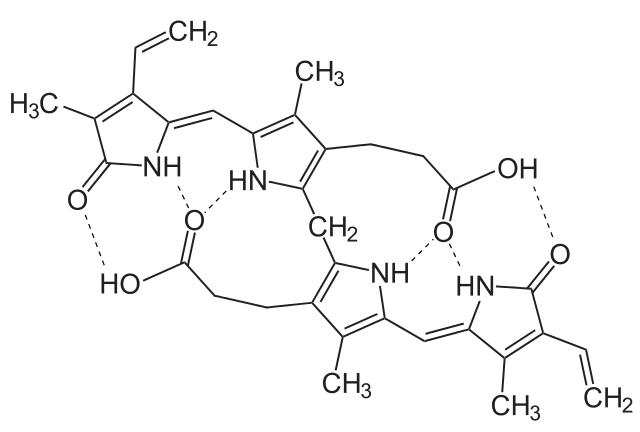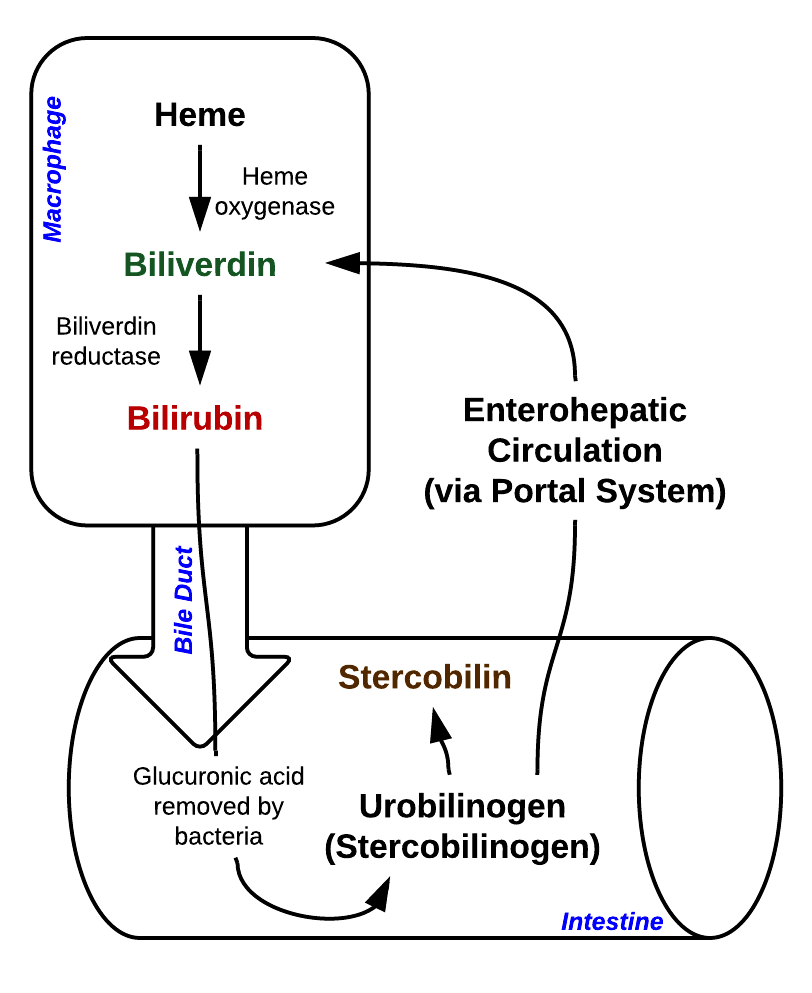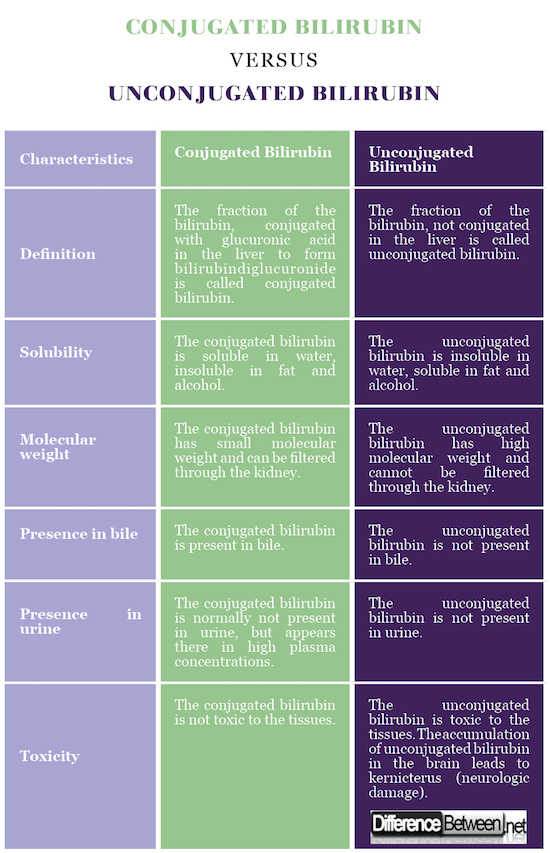Difference Between Conjugated Bilirubin and Unconjugated Bilirubin
Bilirubin is a product of the degradation of hemoglobin (the red blood pigment that carries oxygen from the lungs to the tissues) and some other blood components (heme-containing proteins). It is a yellow-red pigment and is included in the gallbladder bile. Red blood cells (erythrocytes) live on average about 120 days in the circulation, then break down and the hemoglobin degrades to bilirubin.
The increase of the total bilirubin over 30-35 mmol/l results in bilirubin deposition in the tissues and yellow pigmentation of the skin, sclera and mucous membranes. This condition is called jaundice (icterus). Upon increase of serum bilirubin between 22-35 mmol/l, some people may notice slightly yellowish sclera pigmentation, referred to as a subicterus. Jaundice is a leading, though sometimes late, symptom in most diseases of the liver, gallbladder ducts, hemolytic anemias, and many inborn and acquired disorders of bilirubin metabolism.
What is Conjugated Bilirubin?
Approximately 250-300 mg of bilirubin is produced daily in the human body. About 20% of the bilirubin is formed as a result of the breakdown of cytochromes, catalases, peroxidases, and myoglobin. The majority of these breakdown processes occur in the liver.
95% of the unconjugated bilirubin is transported to the liver, associated with blood serum albumin. In the liver, the albumin-bilirubin complex passes into the sinusoidal space, releases the albumin, and the bilirubin molecule is transferred to the hepatocyte. This is where the conjugation process takes place – binding unconjugated bilirubin to glucuronic acid. Mostly bilirubinglucuronide is formed. This conjugated bilirubin is direct and water-soluble. It goes into the duodenum.
In the guts, there are processes of deconjugation оf the bilirubin and reduction from the intestinal bacterial flora to the formation of urobilinogen. Approximately 20% of it is reabsorbed and enters the hepatocyte again via the enterohepatic pathway. An insignificant part of the urobilinogen falls into the bloodstream and is excreted in the urine. In the large intestine, the major part of urobilinogen is converted to a stercobilinogen (fecal urobilinogen) that is oxidized in stercobilin and is excreted in the feces.
The conjugated bilirubin is water-soluble, so it can pass through the kidney filter. It also goes into urine in disease processes that are associated with an increase in conjugated bilirubin in serum. In such cases, darkening of the urine (from dark yellow to brown) occurs.
What is Unconjugated Bilirubin?
Approximately 80% of the bilirubin originates from the breakdown of hemoglobin released by the degradation of obsolete erythrocytes in the monocyte-macrophage system. This happens predominantly in the spleen and to a lesser extent in the bone marrow and the liver (Kupffer cells).
Heme is derived from hemoglobin after separating the globin. After removal of the iron from the heme, biliverdin is formed. Under the action of biliverdin reductase, biliverdin is converted to α-bilirubin – unconjugated bilirubin (indirect). It is not soluble in water. 95% of it is transported from the monocyte-macrophage system to the liver associated with blood serum albumin. The non-albumin-bound bilirubin is fat soluble, has an affinity to the nervous tissue. It is highly toxic and, in large quantities, can cause brain damage – bilirubin encephalopathy.
Difference Between Conjugated and Unconjugated Bilirubin
Definition
Conjugated Bilirubin: The fraction of the bilirubin, conjugated with glucuronic acid in the liver to form bilirubindiglucuronide is called conjugated bilirubin.
Unconjugated Bilirubin: The fraction of the bilirubin, not conjugated in the liver is called unconjugated bilirubin.
Solubility
Conjugated Bilirubin: The conjugated bilirubin is soluble in water, insoluble in fat and alcohol.
Unconjugated Bilirubin: The unconjugated bilirubin is insoluble in water, soluble in fat and alcohol.
Molecular weight
Conjugated Bilirubin: The conjugated bilirubin has small molecular weight and can be filtered through the kidney.
Unconjugated Bilirubin: The unconjugated bilirubin has high molecular weight and cannot be filtered through the kidney.
Presence in bile
Conjugated Bilirubin: The conjugated bilirubin is present in bile.
Unconjugated Bilirubin: The unconjugated bilirubin is not present in bile.
Presence in urine
Conjugated Bilirubin: The conjugated bilirubin is normally not present in urine, but appears there in high plasma concentrations.
Unconjugated Bilirubin: The unconjugated bilirubin is not present in urine.
Toxicity
Conjugated Bilirubin: The conjugated bilirubin is not toxic to the tissues.
Unconjugated Bilirubin: The unconjugated bilirubin is toxic to the tissues. The accumulation of unconjugated bilirubin in the brain leads to kernicterus (neurologic damage).
Summary of Conjugated Vs. Unconjugated Bilirubin
- Bilirubin is a product of the degradation of hemoglobin and some other blood components. It is a yellow-red pigment.
- The increase of the total bilirubin over 30-35 mmol/l results in bilirubin deposition in the tissues and yellow pigmentation of the skin, sclera and mucous membranes, called jaundice
- The fraction of the bilirubin, conjugated with glucuronic acid in the liver to form bilirubindiglucuronide is called conjugated bilirubin.
- The fraction of the bilirubin, not conjugated in the liver is called unconjugated bilirubin.
- The conjugated bilirubin is soluble in water, insoluble in fat and alcohol. The unconjugated bilirubin is insoluble in water, soluble in fat and alcohol.
- The conjugated bilirubin has small molecular weight and can be filtered through the kidney. The unconjugated bilirubin has high molecular weight and cannot be filtered through the kidney.
- The conjugated bilirubin is present in bile, while the unconjugated bilirubin is not present in bile.
- The conjugated bilirubin is normally not present in urine, but appears in high plasma concentrations. The unconjugated bilirubin is not present in urine.
- The conjugated bilirubin is not toxic to the tissues. The unconjugated bilirubin is toxic to the tissues. The accumulation of unconjugated bilirubin in the brain leads to kernicterus (neurologic damage).
- Difference Between Gallstones and Cholecystitis - September 5, 2021
- Difference Between Constipation and Cramping - August 4, 2021
- Difference Between Whole Genome Sequencing and Microarray - May 6, 2021
Search DifferenceBetween.net :
1 Comment
Leave a Response
References :
[0]Boyer, T., T. Wright, M. Manns. Zakim and Boyer's Hepatology E-Book: A Textbook of Liver Disease. Philadelphia: Elsevier. 2006. E-book.
[1]Lightner, D. Bilirubin: Jekyll and Hyde Pigment of Life: Pursuit of Its Structure Through Two World Wars to the New Millenium. Wien: Springer. 2013. Print.
[2]Pelley, J., E. Goljan. Biochemistry. Philadelphia: Elsevier. 2011. E-book.
[3]Image credit: https://commons.wikimedia.org/wiki/File:Heme_Breakdown.png#/media/File:Heme_Breakdown.png
[4]Image credit: https://upload.wikimedia.org/wikipedia/commons/thumb/5/5f/Bilirubin_H_bonded.svg/640px-Bilirubin_H_bonded.svg.png




The site and it’s information is extremely helpful to me as a med-student ,and have been using it for a while, thank you developer.